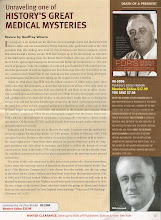My paper of this title will appear in the February 15th issue of NEUROLOGY, the most widely read amd prestigious peer-reviewed neurological journal in the world.
In the last two years of his life, FDR manifesting frequent lapses of consciousness that lasted seconds to minutes that neurologists would recognize as complex partial seizures. Epilepsy is defined and more than one seizure and, as in the case of FDR, many forms of seizures do not involve convulsions. An event that probably occurred the day prior to FDR's last visit to Warm Springs may have been convulsive but there are no direct descriptions, only a report of a "brain hemorrhage" that rapidly cleared by Walter Trohan (who almost undoubtedly got ir from a secret service agent) in the News Story Magazine article linked to this blog. Brain hemorrhages do not clear with such rapidity. The only one that FDR undoubtedly experienced was on April 12, 1945 that killed him. In the opinion of this blogger, it was most likely brought about as a manifestation of bleeding from a metastatic melanoma of the brain, a circumstance that occurs as a terminal event in over one quarter of patients who die of this often fatal form of cancer.
The paper describes three stunning eyewitness accounts (these are also in the book).
Here is a document that came out after the book and that is perhaps the most dramatic, showing that his daughter Anna was well aware of the episodes but, as all other reports, did not recognize them for what they truly were.
Now a bit of educated speculation. Based on the description of the events by Francis Perkins, Turner Catledge, Senator Frank Maloney and a dozen others, combined with thirty years of experience as a neurologist, it is possible that the photograph below caught FDR in the midst of one of his events.
This photo is interesting for a number of reasons. It was taken near San Diego, in FDR's private railroad car, the Ferdinand Magellan, on the occasion of his acceptance of the Democratic nomination for a fourth term, appearing in LIFE Magazine and triggering a major FBI investigation.
As it turns out, the balding naval officer in the foreground is none other than Howard Bruenn, whose constant presence at FDR's side at the time was supposed to be a secret. After a number of Bruenn's colleagues recognized the cardiologist, surmised he was there to treat presidential heart disease and started talking among themselves about it, J. Edgar Hoover and company were dispatched to "squelch the chatter" so to speak. This, of course, turned out to be only the top layer of many calculated deceptions with respect to FDR's health in 1944 and 1945.
I will post the Neurology paper on the day of its publication.








